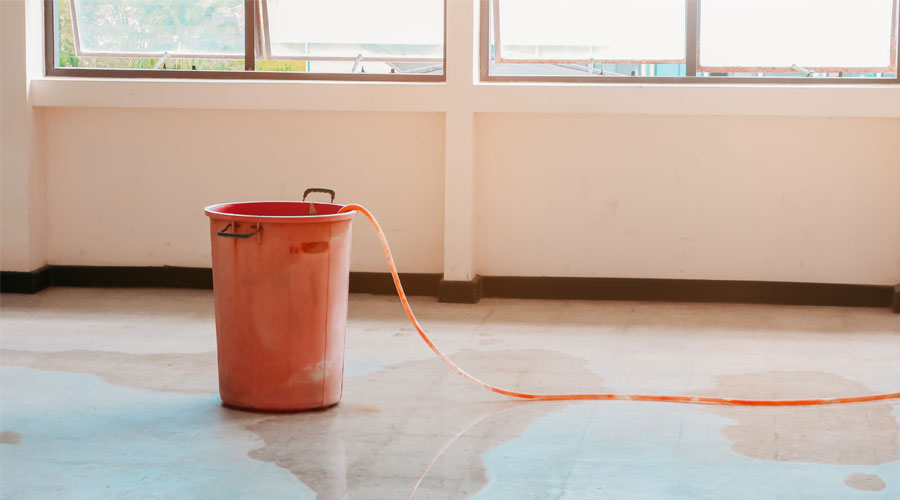
Water Damage Prevention Checklist
Organizations need to have effective protocols to help minimize the likelihood of water damage affecting their assets and operations. Water damage can stem from various sources and cause impacted organizations and their properties to incur significant losses, including destroyed equipment and inventory, prolonged business disruptions, and—in severe cases—structural ruin. The following checklist outlines key water damage prevention measures to keep in mind.
Exterior Property Considerations
ROOFING, SIDING AND DOORS/WINDOWS
- Is the property’s roof routinely inspected and kept in good condition? Have any signs of damage or wear and tear (e.g., punctured flashing, blistered or missing shingles, loose nails and uplifted or sagging materials) been repaired as needed?
- Are all roof vents operating correctly and properly sealed?
- Are all roof-mounted components (e.g., HVAC systems) equipped with weather-resistant devices (e.g., hail guards)?
- Are all gutters kept in good condition, cleaned regularly and effectively guarded? Have any signs of damage or debris buildup (e.g., sticks, branches, dirt or leaves) been addressed?
- Is the property’s siding routinely assessed for signs of damage or wear and tear (e.g., chipping, warping or cracking)? Have these issues been fixed when necessary?
- Are all doors, windows and skylights fully sealed and weather-tight? Are these features monitored for possible damage and repaired as needed?
- Are all window wells adequately maintained and protected with grates or covers?
DRAINAGE AND GRADING
- Are all exterior drains located on or near the property kept clear and free of overgrown vegetation or excess debris? Is the property equipped with automatic backflow or backwater valves?
- Is the property landscaped and graded to promote proper drainage, minimize pooling water and direct moisture away from the foundation?
- Are all downspouts regularly inspected and kept in good condition? Have any signs of damage or wear and tear (e.g., holes or dents) been addressed?
- Do downspouts effectively disperse rainwater, ice and snow away from the property? Have downspouts been equipped with above- or below-ground extension systems as needed?
Interior Property Considerations
SYSTEMS AND PLUMBING FEATURES
- Have wall, ceiling and floor cracks been sealed? Have any signs of water seepage (e.g., staining or discolouration) been addressed?
- Are pipes monitored for signs of corrosion, rust or leaks and repaired when necessary? Have clay pipes been replaced with metal or PVC pipes as needed?
- Are property temperatures always kept above 10 degrees Celsius to prevent frozen or burst pipes? Are pipes located in areas that may be exposed to cold air (e.g., attics and basements) adequately insulated?
- Are all toilets and sinks routinely inspected to ensure they are functioning correctly? Do water supply valves close smoothly, and are water supply lines clearly attached?
- Are the sump pump and interior drains in good condition and clear of excess debris?
- Are all fire suppression and sprinkler systems well maintained and inspected annually by a qualified professional?
- Does a licensed plumber assess the property’s water heater and flush sediment from the tank every year?
- Are HVAC systems inspected regularly and maintained to prevent condensation or leaks?
VALUABLE ITEMS AND OPERATIONS
- Has critical equipment and infrastructure (e.g., production line machinery, electrical systems and IT assets) been identified and placed on upper floors in areas that are less vulnerable to water damage (i.e., away from windows, doors, pipes and drains)? Are vital operations and processes also conducted in these protected locations?
- Are barriers, curbs or pipe channels installed to redirect potential water flow in instances where vital equipment and infrastructure cannot be placed on upper floors or in less vulnerable areas?
- Are sensitive records and materials (e.g., essential files and inventory) stored on upper floors in waterproof containers?
- Are elevators programmed to remain on upper floors when not in use (if applicable)?
WATER DETECTION MEASURES AND BACKUP SYSTEMS
- Is the property equipped with effective water detection features (e.g., liquid level sensors or alarms and remote monitoring technology)?
- Is water damage addressed in the property’s emergency response and business continuity plans?
- Are employees trained to handle water damage, continue operations, and minimize associated losses (e.g., shutting off water valves and protecting valuable items)?
- Are backup systems (e.g., emergency generators, circuits and batteries) readily available on-site if water damage disrupts the property’s essential utilities or operations?
ADDITIONAL WATER DAMAGE PREPAREDNESS MEASURES
- Is a water response cart readily available with essential tools for emergency water leak response?
- Is there a detailed map of all water and liquid systems within the building, with labelled water shut-off control valves for easy access?
- Is there a maintenance scheduled to exercise and lubricate valves annually?
- Are emergency supplies to respond to a water incident maintained and ready to use at a moment’s notice?
Water damage prevention strategies are essential for protecting and maintaining assets and limiting exposures. To learn more about how to protect yourself from these risks, reach out to CMB Insurance Brokers for more information. We can provide you with valuable insights and guidance to help you navigate this challenging market: call CMB at 780.424.2727 or click here to get a quote.
This checklist is merely a guideline. It is neither meant to be exhaustive nor meant to be construed as legal advice. It does not address all potential compliance issues with federal, province al or local standards. Consult your licensed representative at CMB Insurance Brokers or legal counsel to address possible compliance requirements. © 2024 Zywave, Inc. All rights reserved.
